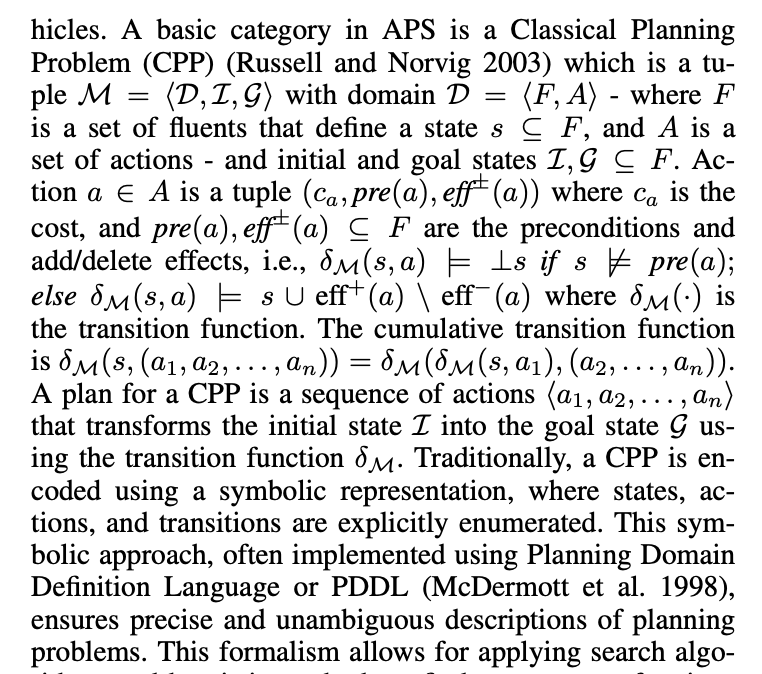[TOC]
- Title: “On the Prospects of Incorporating Large Language Models (LLMs) in Automated Planning and Scheduling (APS).”
- Author: Pallagani, Vishal, et al.
- Publish Year: arXiv preprint arXiv:2401.02500 (2024).
- Review Date: Mon, Jan 29, 2024
- url:
Summary of paper
Contribution
The paper provides a comprehensive review of 126 papers focusing on the integration of Large Language Models (LLMs) within Automated Planning and Scheduling, a growing area in Artificial Intelligence (AI). It identifies eight categories where LLMs are applied in addressing various aspects of planning problems:
- Language Translation
- Plan Generation
- Model Construction
- Multi-Agent Planning
- Interactive Planning
- Heuristics Optimization
- Tool Integration
- Brain-Inspired Planning
For each category, the paper discusses the issues addressed and identifies existing gaps in research. It emphasizes that the true potential of LLMs emerges when they are integrated with traditional symbolic planners, advocating for a neuro-symbolic approach. This approach combines the generative capabilities of LLMs with the precision of classical planning methods, addressing complex planning challenges more effectively. The paper aims to encourage the ICAPS (International Conference on Automated Planning and Scheduling) community to recognize the complementary strengths of LLMs and symbolic planners, advocating for a direction in automated planning that leverages these synergistic capabilities to develop more advanced and intelligent planning systems.
Some key terms
position statement
Integrating LLMs into APS marks a pivotal advance- ment, bridging the gap between the advanced reason- ing of traditional APS and the nuanced language un- derstanding of LLMs. Traditional APS systems excel in structured, logical planning but often lack flexibility and contextual adaptability, a gap readily filled by LLMs. Conversely, while LLMs offer unparalleled nat- ural language processing and a vast knowledge base, they fail to generate precise, actionable plans where APS systems thrive. This integration surpasses the limitations of each standalone method, offering a dynamic and context-aware planning approach, while also scaling up the traditional use of data and past experiences in the planning process.
Causal Language Modeling (CLMs):
- CLMs, such as GPT- 4, are designed for tasks where text generation is sequen- tial and dependent on the preceding context.
Definition of classical planning problem

In-context learning
In-context learning refers to a machine learning concept where a model learns from the context provided in the input data, without the need for explicit external labels or fine-tuning.
Language translation
LT in the context of LLMs and planning involves converting natural language instructions into structured planning language like PDDL, using in-context learning techniques. This capability effectively bridges the gap between human linguistic expression and machine understandable format.
- The LLM+P framework exemplifies this capability by translating natural language descriptions of planning problems into PDDL using GPT-4, solving them with classical planners, and translating solutions back into natural language, especially for robot planning scenarios. (Liu et al. 2023)
Despite these advancements, a critical research gap emerges in the autonomous translation capabilities of LLMs, particularly in converting natural language to PDDL without external expert intervention.
While LLMs effectively translate PDDL to natural language,
- a notable gap is evident in their limited understanding of real-world objects and the problem of grounding affor- dances, mainly when translating natural language to structured languages like PDDL
Model Construction
involves the use of LLMs to create or refine world and domain models necessary for precise planning.
- Gragera and Pozanco explore LLMs’ capability in completing ill-defined PDDL domains.
